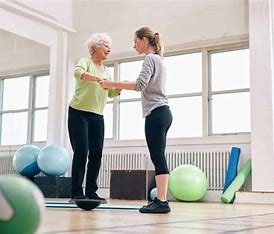
🧠 Why Does Balance Decline With Age or Health Conditions?
As we age or face certain health challenges, several systems in our body that contribute to balance begin to decline:
- Muscle Weakness – Especially in the legs and core, which are vital for posture and stability.
- Joint Stiffness or Arthritis – Reduces mobility and reaction time.
- Vision Loss – Vision is crucial for balance; changes in eyesight affect spatial awareness.
- Inner Ear Changes (Vestibular System) – The inner ear helps us sense head movement and position; deterioration can cause dizziness or instability.
- Slower Nervous System Responses – Aging slows down the communication between brain and muscles.
- Chronic Conditions – Such as Parkinson’s disease, stroke, or diabetes (which can cause neuropathy in the feet) also negatively impact balance.
🧭 Types of Balance
Understanding the types of balance helps us train more effectively:
- Static Balance – The ability to maintain a position without moving, like standing still on one leg.
- Dynamic Balance – The ability to maintain stability while moving, like walking or reaching for something.
- Reactive Balance – The ability to recover from a stumble or being pushed unexpectedly.
Balance exercises often train all three types—helping with everyday tasks and sudden surprises (like tripping).
🏋️♀️ How Balance Training Works
Balance training uses progressive overload, just like strength training. You gradually increase the challenge by:
- Reducing base of support (e.g., going from two legs to one)
- Adding movement (e.g., walking backward, turning)
- Removing visual cues (e.g., closing your eyes)
- Introducing unstable surfaces (e.g., foam pads, balance boards)
- Combining tasks (e.g., talking or catching a ball while balancing)
The goal is to make the body adapt by recruiting stabilizing muscles, improving reflexes, and training the nervous system to react more efficiently.
👥 Who Benefits from Balance Training?
- Older Adults – To reduce fall risk and maintain independence.
- Athletes – For better performance and injury prevention.
- People Recovering from Injury or Surgery – Especially knee, ankle, or hip surgeries.
- People with Neurological or Musculoskeletal Disorders – Including MS, stroke, or Parkinson’s.
- Everyone! – Even healthy adults benefit from improved posture, coordination, and injury prevention.
🧘♂️ Examples of Balance Exercises (From Beginner to Advanced)
🟢 Beginner Level:
- Heel-to-Toe Walk (Tandem Walk)
- Single Leg Stance (stand on one leg for 10–30 seconds)
- Weight Shifts (slowly shift weight from one leg to the other)
- Marching in Place
🟡 Intermediate Level:
- Standing on a Foam Pad
- Tai Chi or Yoga Poses (Tree Pose, Warrior III)
- Step-Ups on a Low Platform
- Balance with Head Turns
🔴 Advanced Level:
- Use of Balance Boards or BOSU balls
- Lunges with Rotation
- Walking Lunges with Eyes Closed
- Jump-to-Balance Exercises
🧠🫀 Bonus Benefits of Balance Training
- Better Posture and Spinal Alignment
- Enhanced Brain Function (requires focus, coordination, and awareness)
- Improved Proprioception – The body’s ability to sense its position in space
- Mental Wellness Boost – Confidence and reduced fear of movement help mental health
